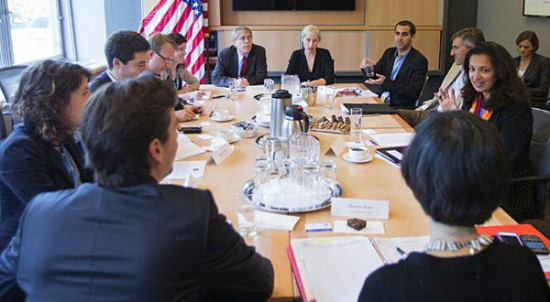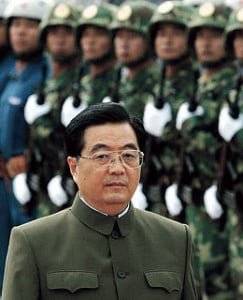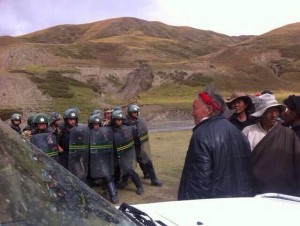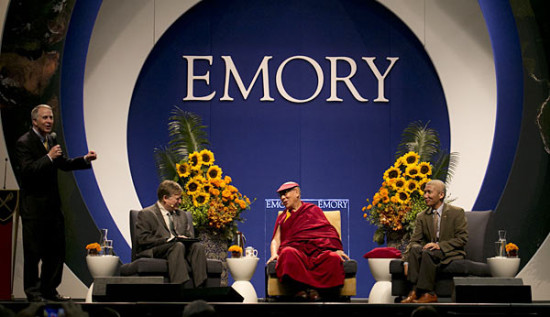China’s human rights failures highlighted at UN

Executive Director of ICT-Germany, Kai Muller, meets with U.S. Acting Assistant Secretary of State Uzra Zeya and other representatives of human rights NGO’s on opening day of the 17th UPR Session.
Chinese diplomats faced challenges and questions over their Tibet policies during the second Universal Periodic Review (UPR) of China’s human rights record, held at the UN offices in Geneva on October 22. Eleven countries raised the Tibet issue during the time allotted for questions, citing lack of religious freedom, minority rights, and access of UN officials to Tibet, and called for the resumption of dialogue with the Dalai Lama or his representatives. While the Chinese diplomats’ immediate dismissal of these concerns was largely expected, the questioning stood as a broadening and deepening of concern for Tibet over China’s previous UPR in 2009, when four countries specifically mentioned Tibet at the Council session.
Spanish court indicts former China leader over Tibet policies

Hu Jintao
UK denies changing Tibet stance to secure trade agreement
Despite the questioning at the UN and growing legal momentum in Spain, Chinese authorities appear to have successfully made diplomatic headway with British officials, leading to renewed concerns over the UK’s longstanding involvement with the Tibet issue and commitment to human rights following the announcement of a new lucrative trade agreement reached during a high-level UK trade delegation visit to China. The official publication of the Chinese Communist Party, People’s Daily, claimed that the new agreements were made possible after UK officials admitted to mishandling the Tibet issue when UK Prime Minister David Cameron and his deputy Nick Clegg met with the Dalai Lama in May 2012; a charge officials in London have denied.
Widening security response follows crackdown in Tibet

People’s Armed Police and unarmed local Tibetans in Garchung Village in Dathang Township, Driru county, Nagchu.
Authorities have moved to clampdown on information regarding the incident, with one police official from the area telling the French news agency AFP, “No protest, no one injured.” Despite the paramilitary lockdown and attempts by officials to prevent news from reaching the outside world, information signaling a widening security response has emerged. In Lhasa, where the Economist recently observed an already “pervasive” security network, officials have directed police to monitor the movement and activities of Tibetans from Nagchu, while a peaceful protest was held in front of a police station in a neighboring Tibetan area of Sichuan province on October 12, after a Tibetan monk who is originally from Nagchu was detained.
Even though the security situation has gone unreported in China’s state-media, the official Tibet Daily and China Tibet News outlets recently carried stories (in Chinese) touting the success of development programs and patriotic activities in Nagchu, including theatrical performances, judicial seminars, and movie screenings, with the China Tibet News specifically highlighting programs in Driru county, the epicenter of the crackdown in Nagchu.
The promotion of development projects and patriotism as the answers to creating a “harmonious” and “stable” Tibet was also on display at the Sichuan Tibetan Buddhist Forum, held on October 9 in the provincial capital of Chengdu. With the heads of various monasteries and several senior-level Tibetan monks in attendance, Li Congxi, the Vice-chairman of the Sichuan provincial Chinese People’s Political Consultative Conference (CPPCC), condemned “separatist and sabotage activates,” while suggesting that the “Tibetan Buddhist community should take the lead in propaganda and guidance… against acts of self-immolation.” In order for Tibetan areas to continue the successes achieved, as Li Congxi sees it, the monastic community should “adapt to socialist society.” Continue reading » (in Chinese)
Reports highlight tense security crackdown in Tibet
While efforts to report on the current conditions Tibetan face continue underway, an extensive review of conditions in Tibet over the last year can be found in a couple of recently released reports. On October 10, the Congressional-Executive Commission on China (CECC) released its 2013 annual report, in which it describes a harsh security atmosphere throughout Tibetan areas. Despite “official concern over the spread of self-immolation” as a means of protest, the CECC found that Chinese authorities “maintained policies and practices that exacerbate tension.”
The CECC found “no indication… of official Chinese interest in resuming a dialogue that takes into account Tibetan concerns,” putting the leadership in Beijing in sharp contrast with findings made by the U.S. State Department earlier this year, which stated that “[s]uch a dialogue provides the best hope for alleviating tensions in Tibetan areas and would contribute to the overall stability of China.”
In addition to “infring[ing] on Tibetans’ freedoms of expression, association, and movement,” the CECC reports that authorities implemented polices which “curtailed their [Tibetans’] ability to communicate or share information,” a similar observation found in Freedom House’s recently released annual report on global internet freedom. While writing that Tibetans are “particularly vulnerable” to China’s state security apparatus, Freedom House noted the “unprecedented levels of surveillance targeting Tibetans, including searches of mobile devises.” These findings come at a crucial time, when Tibetans are prosecuted and imprisoned on long sentences for even low-level information sharing.
Chinese media reacts to Dalai Lama visit in U.S.

His Holiness the Dalai Lama at Emory University.
While the Dalai Lama’s recently completed visit to Emory University in Atlanta did not elicit the level of hysteric vitriol from authorities in Beijing as meetings with world leaders do, the three day event did not go entirely unnoticed by Chinese media. Hong Kong’s Ta Kung Pao, which is seen as having state backing, published an online story of seemingly random images of the Tibetan spiritual leader and the university under the title, “Dalai Lama visits university in America 5 times to spread separatism.” The posting did not elaborate on the title, but did reference the university’s program in Dharamsala, India, home to the Tibetan government-in-exile.

